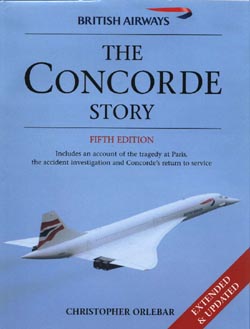 The Concorde Story The Concorde Story
Fifth Edition (extended and updated)
By Christopher Orlebar
Osprey Publishing Ltd, 2002
ISBN 1-85532-667-1
208 pages Christopher Orlebar is a Concorde pilot, so he knows his subject very well. The first edition of this book was published in 1986, since when a lot has happened so this update is very welcome. It begins with a quick look at the prior history of jet and rocket-propelled aircraft and the quest for safe supersonic flight. Then comes the background to Concorde herself, with the story of British post-War airliners and experimental supersonic planes. A partner was needed to help meet the enormous costs of developing a supersonic airliner, and the next chapter covers the discussions for this and the eventual agreement with France. Design and building, up to the first flight, come next and then there’s a look at the competition – the unbuilt Boeing design and the Tupolev Tu144, one of which crashed so tragically at the 1973 Paris airshow. The test and proving flights are covered in some detail too, as is Concorde’s entry into passenger service. Then there are separate chapters on the acceleration and deceleration phases of a typical flight, and on the training of Concorde pilots. The next chapter takes a look at possible future developments – propulsion systems, airframe configuration, and other factors for a hypersonic airliner. A chapter headed “21 years in service” looks at the history of Concorde operations, and then there’s one on the possibility of sub-orbital airliners. All this takes us up to the end of the 20th century. Then, on 25th July 2000, came the disaster at Gonesse. An Air France Concorde leaving Charles de Gaule airport in Paris burst into flame and crashed. You may remember that the cause was established as fuel tank perforation by debris from a tyre burst by a foreign object on the take-off runway. Here there’s a thorough discussion of what happened, why the plane couldn’t simply stop before take-off, and what has been done to prevent such a tragedy recurring. Concorde has returned to successful service, and the final chapter looks at what might follow her. Here’s there’s a look at possible new types of power plant, engineered to reduce the sonic boom that at present means supersonic flight over populated land is not acceptable. The whole book is sumptuously illustrated with colour and monochrome photographs, and there are plenty of technical diagrams and charts too – even the flightpaths used for various routes. Concorde fans need this new edition even if they have one of the earlier ones, and it belongs on the bookshelf of anyone interested in airline safety thanks to its clear exposition of what went wrong in July 2000 and how steps were taken to prevent it happening again. Recommended! Full ordering details, for those without a local bookshop, are on the Osprey website. | 







|
 The Concorde Story
The Concorde Story






